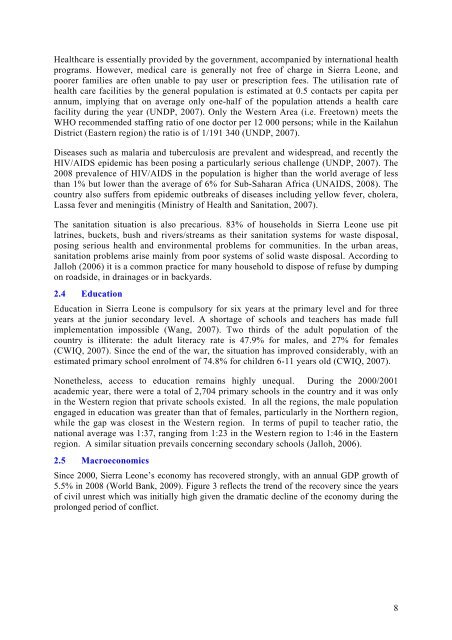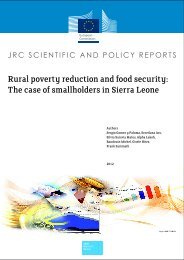The case of smallholders in Sierra Leone - agrilife - Europa
The case of smallholders in Sierra Leone - agrilife - Europa
The case of smallholders in Sierra Leone - agrilife - Europa
Create successful ePaper yourself
Turn your PDF publications into a flip-book with our unique Google optimized e-Paper software.
Healthcare is essentially provided by the government, accompanied by <strong>in</strong>ternational health<br />
programs. However, medical care is generally not free <strong>of</strong> charge <strong>in</strong> <strong>Sierra</strong> <strong>Leone</strong>, and<br />
poorer families are <strong>of</strong>ten unable to pay user or prescription fees. <strong>The</strong> utilisation rate <strong>of</strong><br />
health care facilities by the general population is estimated at 0.5 contacts per capita per<br />
annum, imply<strong>in</strong>g that on average only one-half <strong>of</strong> the population attends a health care<br />
facility dur<strong>in</strong>g the year (UNDP, 2007). Only the Western Area (i.e. Freetown) meets the<br />
WHO recommended staff<strong>in</strong>g ratio <strong>of</strong> one doctor per 12 000 persons; while <strong>in</strong> the Kailahun<br />
District (Eastern region) the ratio is <strong>of</strong> 1/191 340 (UNDP, 2007).<br />
Diseases such as malaria and tuberculosis are prevalent and widespread, and recently the<br />
HIV/AIDS epidemic has been pos<strong>in</strong>g a particularly serious challenge (UNDP, 2007). <strong>The</strong><br />
2008 prevalence <strong>of</strong> HIV/AIDS <strong>in</strong> the population is higher than the world average <strong>of</strong> less<br />
than 1% but lower than the average <strong>of</strong> 6% for Sub-Saharan Africa (UNAIDS, 2008). <strong>The</strong><br />
country also suffers from epidemic outbreaks <strong>of</strong> diseases <strong>in</strong>clud<strong>in</strong>g yellow fever, cholera,<br />
Lassa fever and men<strong>in</strong>gitis (M<strong>in</strong>istry <strong>of</strong> Health and Sanitation, 2007).<br />
<strong>The</strong> sanitation situation is also precarious. 83% <strong>of</strong> households <strong>in</strong> <strong>Sierra</strong> <strong>Leone</strong> use pit<br />
latr<strong>in</strong>es, buckets, bush and rivers/streams as their sanitation systems for waste disposal,<br />
pos<strong>in</strong>g serious health and environmental problems for communities. In the urban areas,<br />
sanitation problems arise ma<strong>in</strong>ly from poor systems <strong>of</strong> solid waste disposal. Accord<strong>in</strong>g to<br />
Jalloh (2006) it is a common practice for many household to dispose <strong>of</strong> refuse by dump<strong>in</strong>g<br />
on roadside, <strong>in</strong> dra<strong>in</strong>ages or <strong>in</strong> backyards.<br />
2.4 Education<br />
Education <strong>in</strong> <strong>Sierra</strong> <strong>Leone</strong> is compulsory for six years at the primary level and for three<br />
years at the junior secondary level. A shortage <strong>of</strong> schools and teachers has made full<br />
implementation impossible (Wang, 2007). Two thirds <strong>of</strong> the adult population <strong>of</strong> the<br />
country is illiterate: the adult literacy rate is 47.9% for males, and 27% for females<br />
(CWIQ, 2007). S<strong>in</strong>ce the end <strong>of</strong> the war, the situation has improved considerably, with an<br />
estimated primary school enrolment <strong>of</strong> 74.8% for children 6-11 years old (CWIQ, 2007).<br />
Nonetheless, access to education rema<strong>in</strong>s highly unequal. Dur<strong>in</strong>g the 2000/2001<br />
academic year, there were a total <strong>of</strong> 2,704 primary schools <strong>in</strong> the country and it was only<br />
<strong>in</strong> the Western region that private schools existed. In all the regions, the male population<br />
engaged <strong>in</strong> education was greater than that <strong>of</strong> females, particularly <strong>in</strong> the Northern region,<br />
while the gap was closest <strong>in</strong> the Western region. In terms <strong>of</strong> pupil to teacher ratio, the<br />
national average was 1:37, rang<strong>in</strong>g from 1:23 <strong>in</strong> the Western region to 1:46 <strong>in</strong> the Eastern<br />
region. A similar situation prevails concern<strong>in</strong>g secondary schools (Jalloh, 2006).<br />
2.5 Macroeconomics<br />
S<strong>in</strong>ce 2000, <strong>Sierra</strong> <strong>Leone</strong>’s economy has recovered strongly, with an annual GDP growth <strong>of</strong><br />
5.5% <strong>in</strong> 2008 (World Bank, 2009). Figure 3 reflects the trend <strong>of</strong> the recovery s<strong>in</strong>ce the years<br />
<strong>of</strong> civil unrest which was <strong>in</strong>itially high given the dramatic decl<strong>in</strong>e <strong>of</strong> the economy dur<strong>in</strong>g the<br />
prolonged period <strong>of</strong> conflict.<br />
8
















